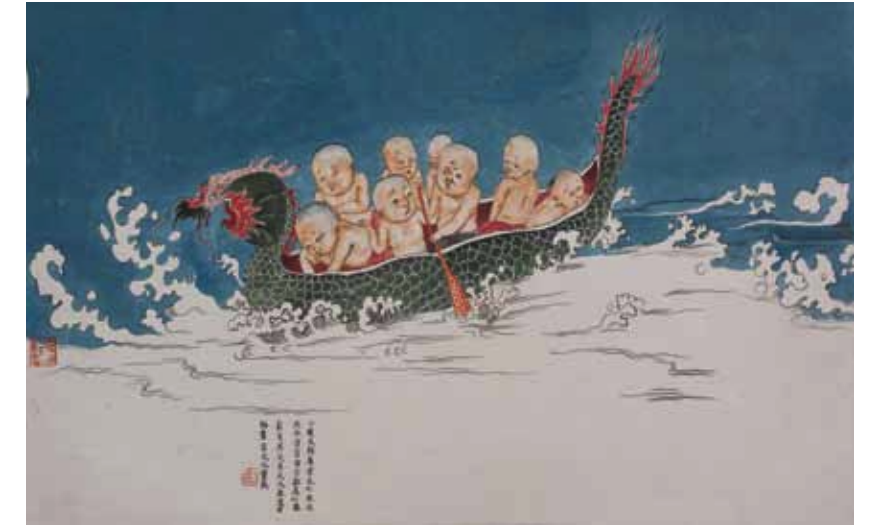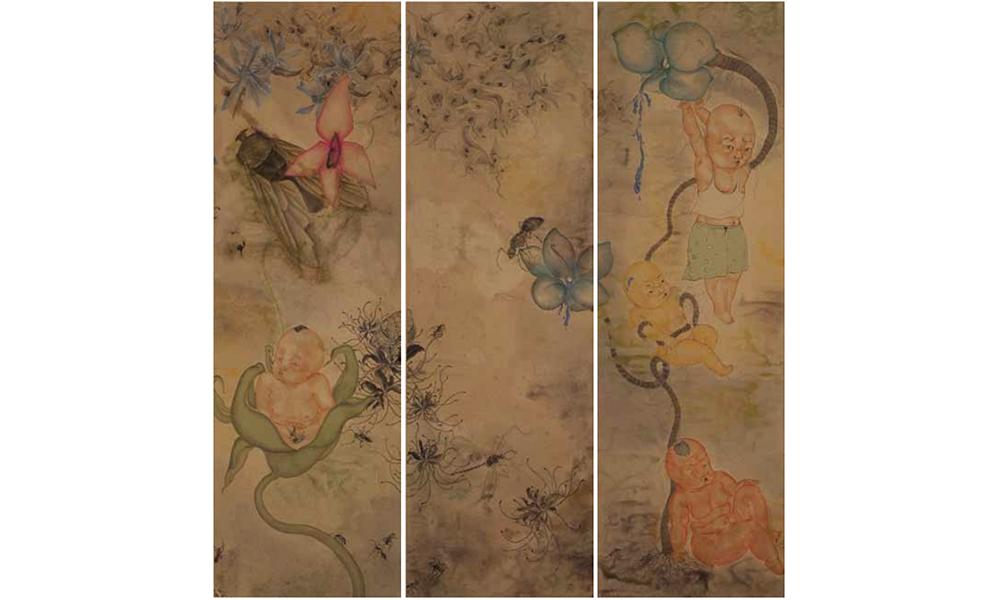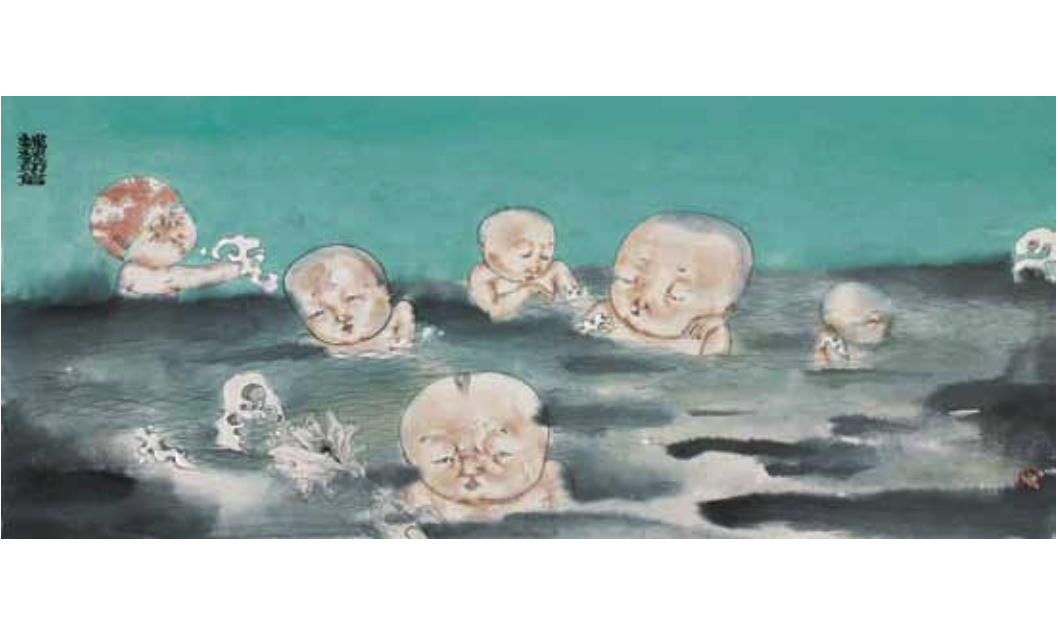“FANTASIA IN INK MAJOR”QU WEIWEI & LI YONGFEI EXHIBITION
“Without tradition, art is a flock of sheep without a shepherd. Without innovation, it is a corpse.” – Winston Churchill
We are delighted to present the joint exhibition of ink artists Li Yongfei and Qu Weiwei, Fantasia in Ink Major, an ink exhibition set to music.
The past quarter century has witnessed such a stir of innovations in the field of Chinese ink brush painting, it has carried with it a buzz that would suggest a medium, its techniques, styles, and very spirit have been reborn, paradoxically as new. In some parts of the world this is indeed the case, coupled with a re discovery of more traditional aspects, while numerous publications and museum shows spotlighting “new ink art” have been undertaken, with further planned in rapid succession. Experimentation in ink art, particularly calligraphy, (the two are inextricably linked philosophically, and practically, through the nature and possibilities of the ink brush) is of course not new, but it is unprecedented in the scale, scope and sustained nature of innovations amongst artists in China and the wider diaspora, whilst breaks with tradition in previous centuries have been viewed as eccentric detours and relatively short-lived. Most notable, however, are the radical changes in the impetus behind ink artists of past eras contra many artists active today, including the duo of artists presented in this exhibition. In broad terms, one could evince that the centre of motivation has moved from the creation of works for societal escapism to creation for societal relevance, from the preserve of an elitist group to evermore a tool for examination of the quotidian. However, this shift has brought with it some challenging questions. How can calligraphy, at once the great unifier amongst the many dialectal tongues in China and mysterious veil from the outside world, be ‘unyoked’, be penetrated by international audiences, and moreover be utilized to better capture the shadings of a world more thoroughly globalized? How indeed can the standard scripts be reinvigorated by contemporary calligraphers, who rely on the same forms realized as early as the fourth century AD, reformulated already many times in the centuries thereafter, and, like ink painting, where preference for impressionistic evocations of the spirit of man and nature rather than realistic renderings of form, were far ahead of chapters of modern Western art? How does the dislocation of man and nature in a contemporary society that has severed its once deep respect for the natural environment manifest itself when conceptually removed from the Shan Shui landscapes of collocated harmony? Internationally known artists such as Xu Bing, Gu Wenda and Hong Lei, have tackled these respective questions admirably, as have still ascending talents such as Gu Gan, Shao Yan and Yang Jiechang. In the process, the most controversial amongst these artists have given new voices to, or even subverted, millennium old traditions. In fact, anyone familiar with the staunch traditions of ink art in China, knows to what extent these artists have had to demolish entrenched boundaries and forge new pathways, in some respects in equal measure or even more so than the internationally named “avant-garde” of the Chinese contemporary art scene, albeit in different capacities. Qu Weiwei, the ink artist also presented in this exhibition, mounts her exploration of recent and contemporary social identities and psychological states in a reinterpretation of China’s long tradition of idealized infant painting. Qu’s often unsettled and disturbing visages are at times distorted and forlorn, at other times knowing and mischievous (in the temper of oil painter Liu Wei’s self-portraits), but never the traditionally homogenized, perennially smiling infant figures. The long history of Chinese figurative ink painting takes account of many forms – from Taoist and Buddhist paintings to great female beauties to folk art – but relatively few variations of the prototype religious or heroic figures. Such innovations of ink artists surely demand a fresh and equally experimental curatorial approach, beyond categorizing their works into prosaic terms whilst we wait for any possible art movements to be detected. Interpretation in ink brush art is considered in China to be key to its essence and evolution; likewise, the advancement of ink painting is considered to lie in large part in its re interpretation.
It is in this spirit that the idea came about of staging an exhibition that would engage a non-visual art form to explore the visual art works of two ink artists who themselves work in inclusive, nonlinear ways, for more lateral interpretations. Precisely, the enactment of visual ‘movements’ linked to the Fantasia, a musical composition epitomized by freedom from structural constraints, struck as mutually qualified, emancipatory even, for the works of these two former Beijing Central Art Academicians. Qu Weiwei’s distinct artistic voices are similarly attracted to grand narration over formalism at their core. What is more, just as the works of these two artists are connected to the past in aspects of technique and styles of ink painting, which they recondition, adding contemporary content and commentary, so too was I interested to create a contemporary breed of the musical Fantasia that was still connected to its heyday roots in the Baroque and Classical periods, and revive it, with extracts ranging from contemporary Chinese pop and rock to white Soul to impressive double-throated Tuvan vocal music (as discovered in Qu Weiwei’s studio). The selection of a Western musical composition as the pretext was quite deliberate, because “…the major calls for modernization [in Chinese ink works of the 20th century] all resulted in the incorporation of elements of Western art into the practice of ink painting”. The works of this duo of artists presented here are no exception.
It is my hope that by contextualizing contemporary ink works in fresh ways, we can also enrich and update our interpretations of ink works from past eras that sewed the seeds for these diverse contemporary works.
– E. S. de W. P.


